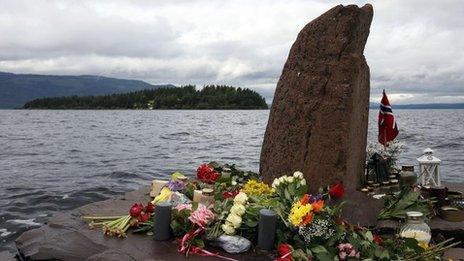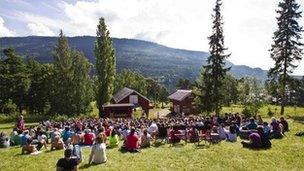Utoeya: How does a country recover from mass murder?
- Published

It's been nearly two years since Norwegian mass killer Anders Breivik murdered 77 people, most of them teenagers. Nearly a quarter of Norwegians knew someone directly affected. But as the country began to grieve together, it also embarked on a unique process of healing.
"It's hard to understand what happened. We read about it. We've seen the movies. But I don't think you can fully understand what happened out there," says Trond Henry Blattman, who lost his son Torjus on Utoeya island on 22 July 2011.
"It was the most secure place to be in Norway that day."
Mr Blattman is now leader of the 7/22 National Support Group for bereaved families, who have gathered for a weekend every six months since the attacks to share their experience of grieving.
It is part of a series of initiatives that offer intensive, targeted, psychological support to survivors of the massacre and the bereaved.
"It is a kind of support to feel that the other families had the same kind of thoughts that you had. How did it happen? Did he suffer a lot?" he says. "You get support from that, to feel that everybody is in the same kind of position."
Collective therapy on a national scale like this had never been attempted before.
The group met for the fourth and final time in February and though many families would have liked them to continue, Mr Blattman says they have done their job.
"The most important thing after the fourth gathering is that people can move on. Of course we lost our child, life will never be the same. It will be different, but hopefully it will be good."
These meetings are part of a co-ordinated effort by the Norwegian authorities to bring help to everyone affected by the attacks.
"Faced with this very large terrorist attack we realised we had to do something special in order to co-ordinate all the groups and organisations," says Dr Bjorn Guldvog, Norway's chief medical officer.
Just two days after the massacre, a group of government agencies and voluntary groups met to form a plan to deal with those affected by trauma.

The camp on Utoeya island was thought to be a safe place
They set up a proactive system of support. Survivors and the bereaved would not have to go find help, it would come to them.
Those affected by the bombing in Oslo, most of whom worked for the government, would get help through their workplace.
The survivors and bereaved from Utoeya Island, who had come from all over the country, would be looked after within their local municipalities.
Local health authorities would be responsible for knocking on doors and making phone calls to them. If help was refused the first time, the idea was they should return later.
However, not everyone necessarily wanted or needed help.
Research shows that there is a natural healing process which, over time, means most people recover from trauma. Statistics range widely and it is thought that anything from five to 35 per cent of people will experience an adverse psychological reaction in the immediate aftermath of trauma.
Without psychological intervention a smaller number will go on to develop serious psychological problems such as Post Traumatic Stress Disorder.
Figures released this year in Norway reveal that around half of all Utoeya survivors are experiencing psychological difficulties.
Dr Alte Dyregrov, head of the centre for Crisis Psychology in Bergen, says there are many reasons why this is higher than average.
The age of the victims and the nature of the attack and where it happened had a profound effect. The young people were somewhere that should have been a very safe place but instead they found themselves being hunted down.
"They struggle with the brutality of the assault, the intrusive images," Dr Dyregrov says.
"This was an hour of fighting for their life. It was a different kind of experience for civilians, they are not military personnel."
Norway learned from previous disasters. After the tsunami in Thailand in 2004 - in which many Norwegians were caught up - they found that bringing people back to the scene of the disaster helped them to deal with trauma and loss.
"It is important for people who have lost their loved ones to be able to go back to the place where that person spent their last minutes and their last seconds, to get a feeling of connection," says Dr Guldvog.
Only a month after the attacks, survivors and the bereaved were taken back to Utoeya island.
With the help of the police they were able to give the exact position where each young person had died and relatives could lay a flower or hold some sort of ceremony on the site.
"Everyone has a lot of imagination in these kind of situations and it is important for them to have as real a picture of what happened as possible. It helps them with coping later," says Dr Guldvog.
"Controlled re-exposure" like this was not new. After a maritime disaster in 1999 in which 69 people survived and 16 died, survivors and the bereaved were taken back to the scene together.
"We had some saying, 'This is how I survived,' while there were others there who had lost their loved ones. That was not a good way of doing it, " says Atle Dyregrov.
"We learned from that not to do it again." Survivors of Utoeya were taken back to the island but on a different day.
Supporting Utoeya victims was made more complex because so many of them were teenagers.
The killing spree happened during the summer holidays and four weeks later young survivors had to start a new school year.
Schools and universities across Norway had to find a way of supporting them as well as those who had lost friends and classmates.
Ronja Breisnes, 18, survived the killing spree on Utoeya by hiding in a toilet for three hours with seven other young people. She texted her mother throughout the ordeal, all the time well aware that her friends had already been killed.
"I experienced a lot of flashbacks and nightmares. I still have them sometimes, repeating themselves," she says. Often she woke up in the middle of the night and couldn't sleep.
When she returned to school, she was regularly late or absent from class. She found it hard to study and struggled with what to tell her classmates.
Her head teacher Hans Vibe had formulated his own plan to deal with the tragedy - he relaxed rules on attendance and performance, usually very strict in Norway.
He also assigned sensitive teachers to teach the classes he knew would be worst affected. He acted on his own initiative but the same advice from the Education Directorate was then rolled out across Norway.
Though what happened on the 22 July 2011 will haunt Norway for many years to come, the way it dealt with its collective trauma offers a blueprint for communities dealing with a national tragedy.
Of course, it helps that Norway is a small and wealthy country but it was the collective, unified response that made the recovery effort possible.
For some like Trond Henry Blattman the act of bringing people together was as much a part of the healing process as the treatment received.
"I think if I had asked Torjus then he would have said, 'This is very important work Dad, I think you need to (do it). This is something you can focus on because you can help a lot of people.'" says Mr Blattman. "He's an inspiration for me."
Healing Norway will be broadcast on BBC World Service as part of The Truth About Mental Health season.